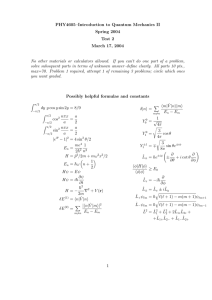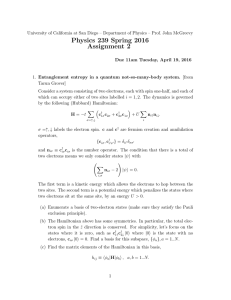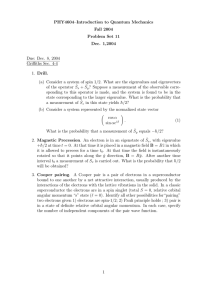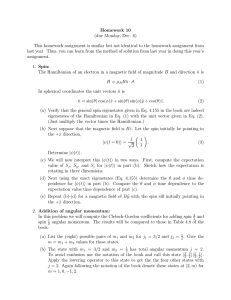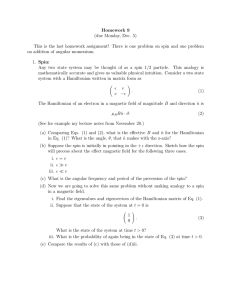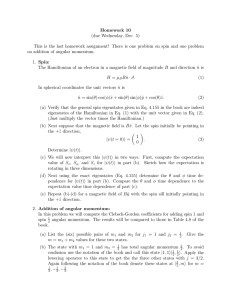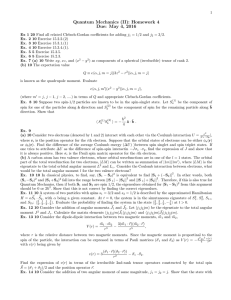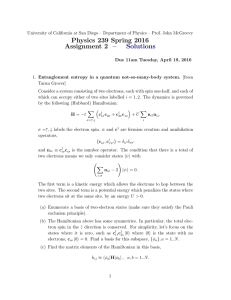PHY4605–Introduction to Quantum Mechanics II Spring 2004 Test 2 Solutions March 17, 2004
advertisement
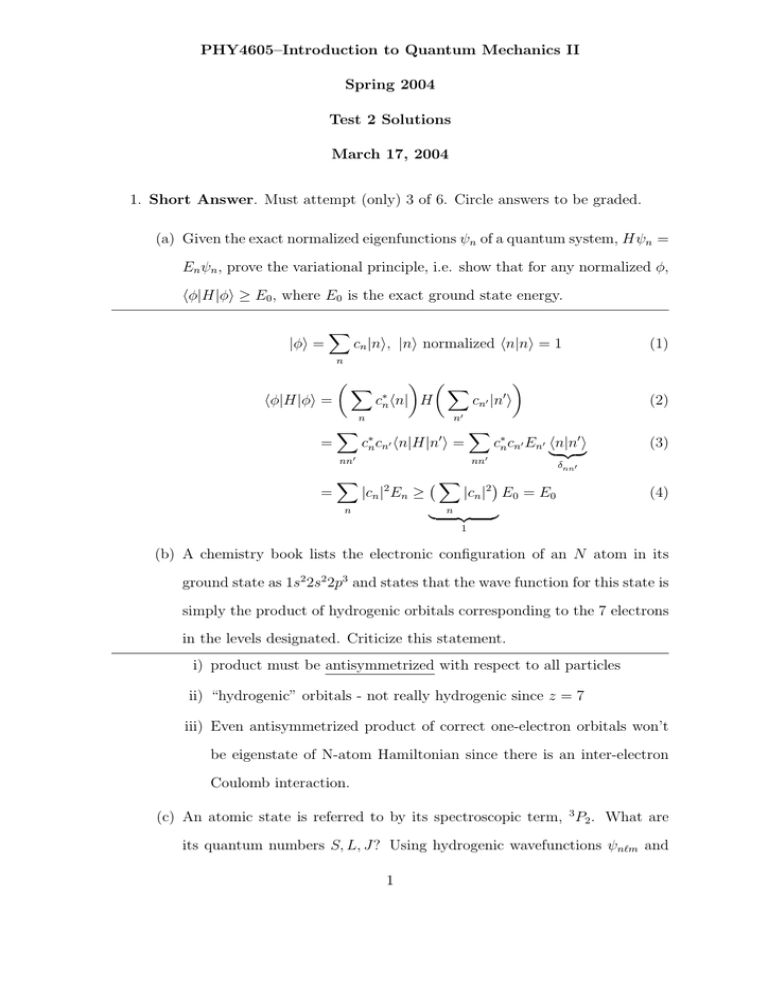
PHY4605–Introduction to Quantum Mechanics II
Spring 2004
Test 2 Solutions
March 17, 2004
1. Short Answer. Must attempt (only) 3 of 6. Circle answers to be graded.
(a) Given the exact normalized eigenfunctions ψn of a quantum system, Hψn =
En ψn , prove the variational principle, i.e. show that for any normalized φ,
hφ|H|φi ≥ E0 , where E0 is the exact ground state energy.
|φi =
X
cn |ni, |ni normalized hn|ni = 1
(1)
n
hφ|H|φi =
µX
c∗n hn|
¶ µX
¶
0
H
cn0 |n i
n0
n
=
X
c∗n cn0 hn|H|n0 i =
X
nn0
=
X
nn0
|cn |2 En ≥
n
¡X
|
n
|cn |
{z
(2)
c∗n cn0 En0 hn|n0 i
| {z }
(3)
δnn0
¢
2
E0 = E0
(4)
}
1
(b) A chemistry book lists the electronic configuration of an N atom in its
ground state as 1s2 2s2 2p3 and states that the wave function for this state is
simply the product of hydrogenic orbitals corresponding to the 7 electrons
in the levels designated. Criticize this statement.
i) product must be antisymmetrized with respect to all particles
ii) “hydrogenic” orbitals - not really hydrogenic since z = 7
iii) Even antisymmetrized product of correct one-electron orbitals won’t
be eigenstate of N-atom Hamiltonian since there is an inter-electron
Coulomb interaction.
(c) An atomic state is referred to by its spectroscopic term, 3 P2 . What are
its quantum numbers S, L, J? Using hydrogenic wavefunctions ψn`m and
1
2-particle spin states |SMS i, write down an appropriate wave function for
2 electrons which might correspond to this term.
¾
2s+1
“term”
Lj S = 1, L = 1, J = 2.
Note J is maximum value, given S = 1, L = 1. Therefore must have
| 2, 2 i = |1, 1, 1, 1i , ML + MS = MJ .
J,MJ
L,S,ML ,MS
(d) Explain the physical origin of fine structure and hyperfine structure in
Hydrogen.
Fine structure: relativistic effects/spin-orbit coupling.
Hyperfine structure: spin-spin interaction between electron and proton.
(e) Angular momentum. Given two angular momenta L1 and L2 , with eigenvalues of the operators L21 and L22 given by 6h̄2 and 15h̄2 /4, what are
the allowed possible eigenvalues of the total angular momentum operator
squared L2 = (L1 + L2 )2 ?
L̂21 = 6h̄2 = L1 (L1 + 1)h̄2 ⇒ L1 = 2
(5)
L̂22 = 15h̄2 = L2 (L2 + 1)h̄2 ⇒ L2 = 3/2
(6)
Allowed values of L: 2 − 3/2 ≤ L ≤ 2 + 3/2 ⇒ 12 , 32 , 52 , 72 .
Eigenvalues of L2 : 43 h̄2 ,
15 2 35 2 63 2
h̄ , 4 h̄ , 4 h̄ .
4
(f) H2 molecule. Sketch the effective potential for the two protons as a function of the distance between them for the ground state and first excited
state. In the same picture, sketch the vibrational levels and explain (do
not calculate) how you would estimate them.
Approximate E(r) near potential minimum in 1 Σg state by simple harq
k
monic oscillator around r0 . Calculate h̄ω0 (n + 1/2), ω0 = m
, k = from
00
E (r0 ), m = mP .
2
2. Ring molecule. In calculating electronic structure of ring-shaped molecules,
one is led to consider simplified models. For example, take two identical fermions
of mass m and spin 1/2, moving on a ring of radius a, with spins constrained
to point up. The particles can interact through a potential of form
V (φ1 , φ2 ) = A cos(φ1 − φ2 )
(7)
where φ1 and φ2 are angular positions of the two particles.
First assume A = 0.
(a) Find all allowed energy levels of this system. (Hint: the only dynamics in
this system are the constrained motion (kinetic energy) of a particle going
in a circle. The Hamiltonian may therefore be written as a rigid rotator
H = L2z /2ma2 ).
Two fermions spins up ⇒ spin wavefunction χ is symmetric ⇒ space wavefunction must be antisymmetric (Pauli). So eigenfunctions with A = 0 are
Ψ = ψ(φ1 , φ2 )χ↑↑
µ
¶
1
= √ ψi (φ1 )ψj (φ2 ) − ψi (φ2 )ψj (φ1 ) χ↑↑ ,
2
(8)
since there is no interaction yet, i, j index exact eigenstates.
Hamiltonian:
L2z1 L2z2
+
, I = ma2
2I
2I
¢
h̄2 ¡ 2
2
=−
∂
+
∂
φ2
2ma2 φ1
H=
single-particle wavefunctions: ψm (φ) =
(9)
√1 eimφ .
2π
(b) Find the ground and 1st excited state wave functions.
(c) State the degeneracies of the ground and 1st excited states.
General excited function consistent with Pauli:
Ψmm0 = √
¤
1 £ imφ1 im0 φ2
0
e
e
− eim φ1 eimφ2 χ↑↑
22π
3
(10)
nonzero only for m 6= m0 !
¢
h̄2 ¡ 2
02
HΨ =
m
+
m
Ψ
2
|2ma {z
}
(11)
Emm0
Ground state: m2 + m02 = 1 [0, 1], [0, −1], [1, 0], [−1, 0] ⇒ 4fold degenerate.
1st excited: m2 + m02 = 2 [1, −1], [−1, 1], [1, 1], [1, 1] ⇒ only 2-fold degen| {z }
Pauli says no!
erate.
Now assume A is nonzero but weak, A ¿ h̄2 /(2ma2 ).
(d) Find the energies and degeneracies of the states in part c) to first order in
A.
δE = hmm0 |V̂ |mm0 i
ground state |10i =
A
hV̂ i = 2
8π
=−
Z
A
8π 2
√1
22π
¡
eiφ1 − eiφ2
¢
¡
¢
dφ1 dφ2 cos(φ1 − φ2 ) |{z}
2 −ei(φ1 −φ2 ) − ei(φ2 −φ1 )
0
Z
dφ1 dφ2 2 cos2 (φ1 − φ2 ) = −A/2
|
{z
}
(12)
4π 2
In fact hmm0 |V̂ |mm0 i = −A/2 for |m − m0 | 6= 1, 0 otherwise. Degeneracy
is not broken at this order.
4
3. H − Ion. Consider an H − ion, which is a hydrogen atom with two electrons.
(a) Write down the Hamiltonian for this system. You may assume that the
proton is infinitely heavy.
H=
p̂21
p̂2
e2
e2 e2
+ 2 +
− −
2m 2m |r1 − r2 | r1 r2
(13)
(b) Show that, if you neglect the Coulomb interaction between the electrons,
the Hamiltonian separates into equations for each electron.
H = H1 + H2 , H α =
p̂2α
e2
−
2m rα
(14)
“Additive Hamiltonian theorem”⇒
E = E1 + E2 , ψ = ψ1 (r1 )ψ2 (r2 ) is a solution.
(15)
(c) Continue to neglect the Coulomb interaction between the electrons, and
assume that both electrons are in the ground (n = 1) state. Write a valid
wavefunction Ψ1s1s for the electrons, including specification of the possible
spin states. Do the same for one electron in a 1s state and the other in a
2s state, Ψ1s2s .
symmetric
antisymmetric
1
Ψ1s1s = ψ1s (r1 )ψ1s (r2 ) χsinglet , χsinglet = √ (↑↓ − ↓↑)
2
£
¤
Ψ1s2s = ψ1s (r1 )ψ2s (r2 ) ± ψ1s (r2 )ψ2s (r1 ) χsinglet
triplet
↑↑
χtriplet = √1 (↑↓ + ↓↑)
2
↓↓
(16)
(17)
(18)
(d) Including the Coulomb interaction between electrons, would you expect
spin triplet states to be lower or higher in energy than spin singlet states
with the same orbital quantum numbers? Why?
5
Triplet states spatially antisymmetric⇒ two electrons spend less “time”
2
close to each other⇒ lower energy since h re12 i is minimized.
6
4. Angular momentum.
(a) Sketch the angular and radial forms of the hydrogenic wavefunctions φn`m
for the cases (n = 2, ` = 1, m) and (n = 3, ` = 1, m). Make sure you make
a separate sketch for each of the 2l + 1 degenerate cases.
(b) Given eigenstates of angular two independent angular momenta L1 and L2
designated by |`1 , m1 , `2 , m2 i, consider the state
1
1
1
|Ψi = √ |2, 2, 1, −1i + √ |2, 1, 1, 0i − √ |2, 0, 1, 1i.
3
6
2
(19)
Show that this state is an eigenstate of total Lz ≡ L1z + L2z with m = 1.
Each state in sum has m1 +m2 = 1 ⇒ eigenstate of total Lz with eigenvalue
h̄.
(c) Show that |ψi is an eigenstate of total L ≡ L1 + L2 with L = 2.
Use:
L2 = L21 + L22 + 2L1 · L2
¡
¢
= L21 + L22 + 2 L1z L2z + L1+ L2− + L1− L2+
(20)
(21)
Check:
−4
2L1z L2z |Ψi = √ |221 − 1i + 0 · |2110i + 0|2011i
3
√
1
1 √ √
1 √
L1+ L2− |Ψi = √ · 0 + √ 6 − 2 2|221 − 1i − √ 6 2|2110i
3
6
2
√
1 √
1 √ √
1
L1− L2+ |Ψi = √ 6 − 2 2|2110i + √ 6 2|2011i − √ · 0
3
6
2
¡
¢
¡
2 ¢
L2
4
√ + √ |221 − 1i
2 |Ψi = L1 (L1 + 1) + L2 (L2 + 1) |Ψi + −
h̄
3
3
√
√
¡ √
¢
2 2
+ − 6 + √ |2110i + 2|2011i
3
¡
¢
1
= 2(2 + 1) + 1(1 + 1) |Ψi + (−2) √ |221 − 1i
3
1
1
+ (−2) √ |2110i + 2 √ |2011i
6
2
= (6 + 2 − 2)|Ψi = 6|Ψi = 2(2 + 1)|Ψi
7
(22)
(23)
(24)
(25)
(26)
(27)
(28)
(29)
(d) Use the lowering operator to find the eigenstate of L2 and Lz with L = 2
and m = 0 (call it |` = 2, m = 0i) in terms of the |`1 , m1 , `2 , m2 i basis.
L− = L1− + L2−
(L1− + L2− )|Ψ21 i =
(30)
√
6|Ψ20 i
(31)
1 √
1 √
1 √
= √ 6 − 2|211 − 1i + √ 6|2010i − √ 6|2 − 111i
3
6
2
(32)
1
1 √
1 √
+ √ · 0 + √ 2|211 − 1i − √ 2|2010i
3
6
2
√
√
= 3|211 − 1i − 3|2 − 111i ⇒
1
1
|Ψ20 i = √ |211 − 1i − √ |2 − 11i
2
2
8
(33)
(34)
(35)
